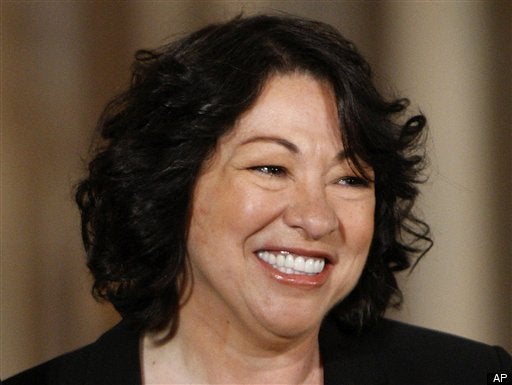
For more than sixty years Celina Sotomayor's life experience has reflected the evolution of the New York Puerto Rican community. As witness and participant, she puts a face on thousands of migrants like her, who braved dislocation, discrimination and disillusionment for a better life. Shattering ethno-racial and gender stereotypes, hers is a story of family, survival, and perseverance much like that of her compatriots with one distinct difference. Her daughter is President Obama's nominee for the U.S. Supreme Court, the first Nuyorican to be so honored.
Celina Sotomayor's modest origins are as compelling as the story of her daughter's imminent ascension to the Supreme Court. When Judge Sotomayor openly acknowledged her mother as her mentor and role model, giving credit where it was deservedly due, the media pounced on the elder's own "rags to riches" tale: a diligent worker, single head of household bucking a hardscrabble existence, raising responsible children with constructive values, and making sure they received good educations. And everywhere Puerto Ricans rejoiced! - embracing the story as their own.
In press coverage of Celina's birthplace, the sleepy southwestern town of Lajas, Puerto Rico, even the cemetery merited a photo in the New York Times. The media mined Celina Sotomayor's past as a Prospect Hospital telephone operator and later a registered nurse. They pressed Bronxdale Housing residents for tidbits of information about project life, marveling that Sotomayor's bright Puerto Rican child had reached such heights from such low surroundings.
Positive public images of this family have captured the nation's imagination far more effectively than all the reams of research about the New York Puerto Rican experience have done over the last fifty years. What has not been noticed is that Celina's was a Puerto Rican woman's story, reflecting countless personal narratives since Boricuas first set foot in the city more than a century ago imprinting their experience in New York's history.
Celina's story deflates a string of negative stereotypes long associated with Puerto Rican culture. The first was shattered in 1944 when Celina joined the army. Seventeen year old females were expected to marry and raise families, not become soldiers. But Celina was in good company. Between 1940 and 1945 two hundred Puerto Rican women were actively recruited for the Women's Army Corps. Many were bilingual and trained as interpreters, cryptologists, and in communications. The Army Nurse corps included thirteen Puerto Rican women assigned to the care of the Spanish-speaking wounded. Celina's army background in communications provided skills she would need to make a living in New York.
In the 1950s Celina and her husband, Juan Luis Sotomayor, formed part of the post-war "Great Migration." An intact family with strong work ethics, the Sotomayors dispelled the notion that migrants flocked to the city for the welfare benefits. For thousands of Puerto Ricans seeking jobs, New York's booming post-war economy offered viable prospects. Women worked in the garment industry, factories, restaurants, and commercial laundries. Their cheap labor helped keep New York's garment establishments afloat. Latinas left the home for the workplace, not to build careers or find something interesting to do in their leisure time, but out of sheer necessity. Those who stayed at home entered the informal economy minding other women's children or sewing piece work in the home, taking in boarders and selling home cooked meals. Nuyorican kids recall learning their numbers by counting the finished garment pieces their mothers produced. These meager earnings often covered tuition for a Catholic school education. Sometimes it stretched enough to put a Christmas doll on lay-a-way in July.
Celina Sotomayor returned to college in mid-life to earn a degree in nursing. As a registered nurse, the family income would increase and Judge Sotomayor recalls her mother hitting the books before dawn and after midnight. Such commitment required unconditional familial support, and the nurturing environment of an extended family. Education mattered to the Sotomayors as it did for other Puerto Rican families. The emerging Nuyorican reality combined experiences and traditions from both world contexts, and differed markedly from the switchblade-wielding, "otherness" introduced worldwide by the iconic musical West Side Story.
Everyone had a right to an education, but if your English was limited or you lived in the barrios, the chances of completing high school were rather slim. By the 1970s educational rights for Latinos were hotly contested issues. Grass-roots organizations demanded decentralization of the public schools, bilingual education to level the playing field, and relevant academic programs that addressed the needs of Puerto Ricans. Civil and gender rights' struggles influenced Celina Sotomayor's contemporaries and the numbers of Latina professionals began to increase. One activist, Antonia Pantoja, believed Puerto Ricans needed to create their own institutions, educate their own leaders and ultimately assume leadership positions that could transform all facets of American society. With a cohort of allies, she created ASPIRA in 1961, today a national educational organization that continues to promote these objectives. Heady issues such as these permeated the barrios motivating Latinas to brave uncharted waters. Celina Sotomayor was no exception.
Today she proudly reflects on the undeniable successes of her distinguished daughter saying, "I don't know what I did...I was just there." Like other Puerto Rican mothers of her generation, Celina Sotomayor did much more. She surmounted life's obstacles and set the examples that defined her daughter's aspirations.
